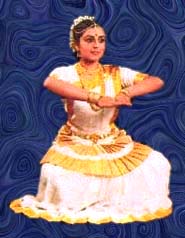Mohiniattam
History and Origin
 This wonderful dance originates from Kerala and is a feminine dance form. Mohini Attam has an extremely, slow seductive quality. It has only been in recent decades that Mohini Attam has risen in popularity and acceptability. The dance form of Mohiniattam was nurtured in the region of Kerala in southwestern India. The name Mohiniattam literally means 'Dance of the Enchantress,' and it does have a mesmerizing quality. The white and gold costume, arresting hairstyle and the highly graceful movements in medium tempo, contribute to this aesthetic effect.
This wonderful dance originates from Kerala and is a feminine dance form. Mohini Attam has an extremely, slow seductive quality. It has only been in recent decades that Mohini Attam has risen in popularity and acceptability. The dance form of Mohiniattam was nurtured in the region of Kerala in southwestern India. The name Mohiniattam literally means 'Dance of the Enchantress,' and it does have a mesmerizing quality. The white and gold costume, arresting hairstyle and the highly graceful movements in medium tempo, contribute to this aesthetic effect.
Mention of Mohiniattam is found in some eighteenth century texts, but the practical aspect of the style was revived in the reign of Maharaja Swati Tirunal, a 19th century ruler who was a great patron of the arts. Under Swati Tirunal, Mohiniattam crystallized as a solo dance tradition with musical compositions set to the Carnatic style of music and a distinct repertoire. Later, in the twentieth century, the great poet Vallathol established the Kerala Kalamandalam to promote the arts of Mohiniattam and Kathakali. Here, further research was done and Mohiniattam was codified and revived.
Performance & Features
The dancer in white costumes, her hair bedecked with white flowers, with extensive eye movements and fluid grace of the waist. It is a very enjoyable classical dance form, performed mainly by female artistes. The dance is accompanied by cymbals, song and drum and simple footwork. The hands flow like a snake or like the ripples of water. The grace of Mohiniattam is appreciated by all.
There is a typical costume for Mohini Attam. It is generally simple and white, or off white. Usually there is a gold brocade, possibly with a border of red. One of the most characteristic signs of the Mohini Attam dancer is the bun of hair worn off-centre. This is very much a characteristic of women from Kerala.
 The myth of Mohini is central to the performance. According to the story, Brahma tells the other Gods how they can obtain amrit (celestial ambrosia); amrit bestows immortality and great power. He informs them that they can do so by churned up the ocean of milk. Unfortunately, the job is so great that the gods are forced to seek the assistance of the demons. The demons agree to help, but are secretly plotting to keep it all for themselves.
The myth of Mohini is central to the performance. According to the story, Brahma tells the other Gods how they can obtain amrit (celestial ambrosia); amrit bestows immortality and great power. He informs them that they can do so by churned up the ocean of milk. Unfortunately, the job is so great that the gods are forced to seek the assistance of the demons. The demons agree to help, but are secretly plotting to keep it all for themselves.
So the fateful day finally comes. The amrit has been rendered, but only after many difficulties. Vishnu finds out about the plot to steal the amrit. He knows that it would be disastrous for the demons to obtain such powers.
Vishnu decides to thwart the demons in their plans to steal the amrit. He takes the form of a beautiful celestial nymph (apsara), and by way of her amorous charms distracts them from their plans. By means of this distraction the amrit is given to the gods, and the world is saved from the demons.
Today
Mohini Attam is just beginning to be accepted outside of Kerala. One is starting to find it used at toward the end of Bharat Natyam perfomances. Therefore, one is starting to find instruments that are normally associated with Bharat Natyam (e.g., mridangam, vina, venu). However more traditional forms use instruments such as shuddha madalam and edakka (uddaku).
Over the past few decades, the repertoire of Mohiniattam has been developed and expanded by dedicated performers who have ensured that this beautiful dance style retains a distinct identity among the classical dance styles of India. Apart from mythology, Mohiniattam contains a range of themes from nature.
- More Dances: Bharatnatyam | Kathak | Kuchipudi | Manipuri | Mohiniattam | Kathakali | Odissi
